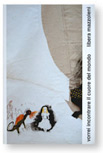 go back >>
go back >>
VORREI
INCONTRARE IL CUORE DEL MONDO
essay
by critic G. Longoni with a brief text by the artist. In Italian/English/French.
46 pages, 12 colour images with poems,
cm 17 x 28; Edizioni d’Arte,
Milan 1997.
BETWEEN MEMORY AND UTOPIA
Graziella Longoni
|
As human beings we are like guards and for it
we shouldn’t forget our duty nor should
we leave our place.” (6, Orphic fragments)
When horror is part of our daily life, when we are worn out and exhausted for it, our life becomes a long tear, a huge cry, a staring silence before nonsense, the darkness of doubtful hiding places, insomnia and a sensation of fear which hit our body and empty our mind, the loss of what was familiar to us, a feeling of unbreathless anxiety, of confusion and a physical and mental fatigue which seems to plead for an end to everyone’s misery. In spite of all this, of the violence of horror striking hope and making time a cold repetition of burial rites, there is a weak hand stretching out, leaning forward.
This hand belongs to a boy. Crossing and breaking the veil of nothing settled upon the world, it realizes an aesthetic gesture, able to express a sensibility, a particular way of feeling. That small hand, which collects pencils and spreads the colours on a white paper, creates shapes and draws lines.
In this way a new sensation awakes and reveals a state of misery and nostalgia, which is the metaphor of death and dreams of life. This sensation takes different shapes: it is a dragon spitting on a blonde little girl wrapped by a dark night; a black door nearly falling upon another girl’s head; a foggy wind taking away and amplifyng her cry; a bloody skull crushing the roofs of a house; the empty orbits of her eyes holding everyone else’s face imprisoned; raising arms peircing the forehead of the skull; hands touching a ceiling made of thick pitch which wipes out the sky; houses burning; falling bombs; a never more lighting and warming dark sun; but this sensation is also a picture of puppets, with the wings of a butterfly and coloured hair, and of a garden full of flowers, which seems to be far away from human horror. Showing a tender touch, Libera Mazzoleni collects the lost pages of this book illustrated by the children of the world, a book which isn’t finished yet. With a great care, minding not to change them, she lays those pictures upon wounded canvas which look like haunted seams amplifyng the human tearing.
In this way she forces us to pay attention and we cannot but look, sadly, at those repaired creases, metaphor of many broken lives. Her art echoes the children’s aesthetic gesture; she accepts it and gives it a higher meaning gathering the flowing of time and tracing the borders of a space which contains the other side of history, of our “short century”, full of obscurantism, prejudices, cruelty, insanely attracted by death, often seen as palingenesis, a renewed life.
Libera Mazzoleni’s language becomes then the poetic word of suffering and the memory of an aching past depicted in all her images. It seems that her gesture wants to tell what, according to Colli, happens to the artist: “This is what happens to the artist: he broke the web of abstraction, he took away the thin frame of optimism, where violence seems hidden by the illusion of our cherished purposes...” In the last painting, the painter places himself between the silence of a blind sacred and the symbol of justice, which isn’t able to balance and harmonize the parts, he reminds the colours of alchemy, which is a process of metamorphosis and a way to everyone’s rebirth, and he holds in his hand a mirror which reflects the whole, i.e. the egg reminding Orpheus, to which the dark-winged Night gave birth and from which “the beloved Eros” would be born. It seems, from the images of this last painting, that the artist tries to rebel against the cruel game of necessity and, dazed by its mortal rationality, he tries to remember that hope is a human duty and, as life, it deserves to be respested and welcome. In this way memory, “nuse and mother of thought” (Zambrano), joins utopia, nourishment of a moving thought living in a continuous and an endless tension of questioning.
|
In northern Prague
Libera Mazzoleni
In northern Prague we can find Theresienstadt, a small town of Czechoslovakia; its streets are examples of a planned architecture, dark and severe, and they preserve the memory of a past painly in contrast with the immaterials borders of the sky. I entered into the close concentration camp of Terezin, as a tourist, I crossed all the courts while my feet were drawing, on the pavement, the rythm of a step whose sound wouldn’t propagate in the air but would become more metallic and deafening, displacing my thoughts, full of horror, through the time... In the south I visited that ancient land which supported the trusting man with the sea water; a land whose amazing brightness becomes part of the time; where people of different religions find their origin in the same temples.
Thete I overcame prohibitions, road blocks, discriminations and I saw the memory of pain in children’s eyes. In the centre of Europe these young artists draw with trembling hands. I would like to go away, to forget the eyes I have met, even those belonging to the ones I didn’t know, though, in my mind, places, time and events are mixing within a sensation of affection. That is why my timorous hands can’t help repeating that aesthetic gesture which turned into shapes, colours and images the arrogance of those hateful men. |
|



